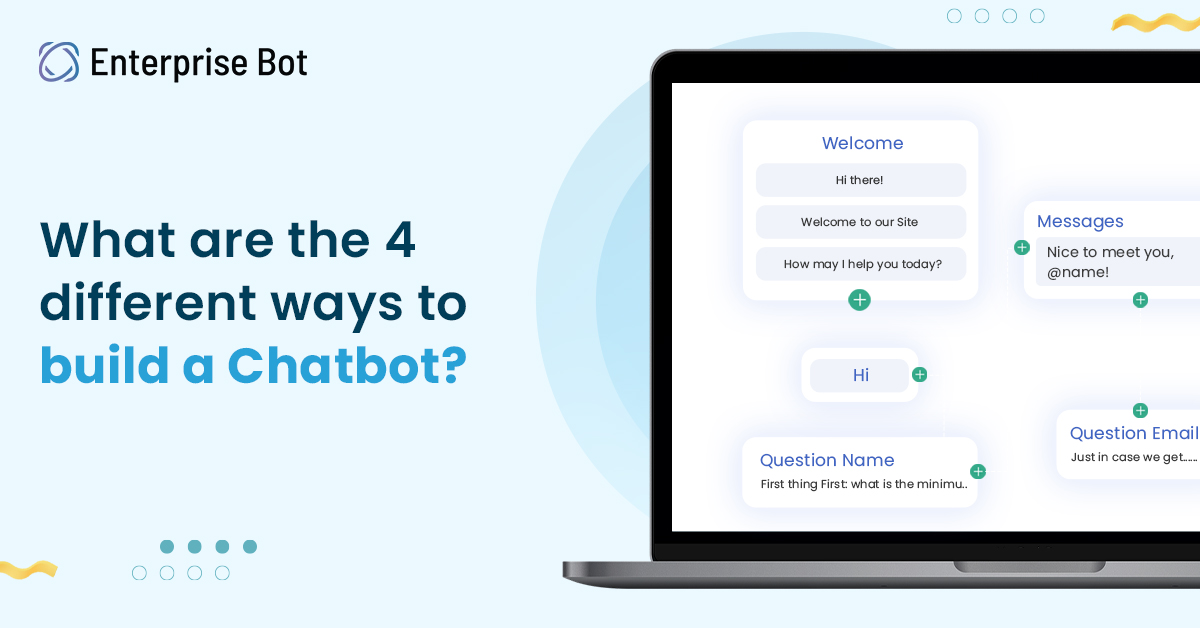What are the 4 different ways to build a Chatbot?
Building a bot from scratch is not an easy undertaking. Several questions might arise early on for which you might not have a distinct answer! This could slow down the process and have a detrimental impact on the bot’s accuracy. One thing that needs to be considered right from the beginning, which is often neglected, is the structuring of the Chatbot. This post will give you an insight into the different options and best practices for building your chatbot as efficiently as possible.
First, let’s have a look at the different possibilities to structure your bot. For chatbots, there are three significant options: Intent-Based (IVA), Flow Builder (Blitzico) and Product Engine. Each of these options has its distinctiveness that might suit specific use-cases better than the other.
Let’s take a deep dive into the best possible method to structure your bot.
Use case 1:
Let’s assume you want your bot to be able to answer several FAQs Let’s assume you want your bot to be able to answer several FAQs which have a straightforward answer, such as “Where can I find the CVV on my credit card”. In such cases, it is a good idea to add each topic to your Intent-Based Admin, which is the main platform to build AI-based bots. When a customer asks the bot a question, the AI will interpret the intention and meaning of the query and will assign it to the right intent. These types of conversations can be seen as “customer-guided” conversations, as the customer asks the questions and the bot provides the answer.

Use case 2:
An example of a use case that would be perfect for our flow builder is a click-bot. A click-bot guides the user through a specific flow by providing several suggestion buttons that formulate questions for the customers. As such, we can call these conversations “bot-guided”, as the bot guides the user through a specific flow without the need for any AI. With the flow builder, you can achieve quick results without having to exert much effort.
Use case 3:
Not every use-case consists of just a straightforward answer. Hence, over here, click-bots can be restrictive. For example, how do you structure your bot if there are multiple use-cases and many of them have complicated flows to achieve the right result? A click-based approach would not work if there were multiple different use cases. You would need to ask follow-up questions, and based on the response, provide different options. Creating everything in the Intent-Based Admin would be extremely cumbersome and requires a lot of extra work. That’s where you would want to link some intents to a flow (for example: In Enterprise Bot, you could combine the IVA platform with the Blitzico feature). The drag and drop interface makes it easy to build any various flows, and on top of that, many prebuilt templates are available to enhance your flow. Keeping the overview after creation is also very straightforward and it can be easily modified when changes are required. 90% of the bots would use this combined approach.
Use case 4:
Finally, if you have a wide range of products for which the questions are similar but require different answers, then both the Intent-Based Admin and the Flow Builder fall short of the mark. For example, the answer for spectacle insurance coverage would be different for Product A v/s Product B. Similarly in IT, the process to reset your password for Software A versus Software B could be completely different. In finance, a bank offers several types of bank accounts, and each bank account comes with different options or features, such as costs, interest rates, minimum balances etc. It would be difficult to handle all these products by deploying separate intents in the IVA, as the word vectors would not be able to differentiate the requests due to the similarity in the questions. It would lead to a lot of mistakes and your accuracy will suffer. By putting all these similar questions into one single intent and then using the extracted parameters to provide product and feature specific responses, you will achieve much higher accuracy and a better customer experience.
What’s more, if the customer has mentioned a product before, then they do not have to keep repeating themselves. For example, if a user had previously enquired about the costs for a specific bank account and they simultaneously wanted to know more about the interest rates, then they only need to enquire about the interest rates without having to mention the bank account again. The bot will remember the product from their previous question and will share the answer for the product and newly mentioned feature. Context handling, accuracy and scalability are the major benefits of using a product engine in such cases.
(Please note: Product Engine is an Enterprise Bot proprietary feature that you will most likely not find with other providers. However, another option is to create a custom database of products and features.)
In most cases, you will probably use a combination of the different options, because chatbots usually do not serve single or easy use cases. Several use cases, one more complex than the other, might be included in your chatbot so it is crucial to know how you want to accomplish each use case as efficiently as possible. So, before you begin building your bot, ensure that you are aware of which tasks you want your chatbot to be able to handle, specify your use cases and define the structure of your bot accordingly so you are on the right track from the beginning.




